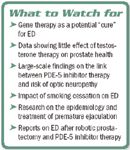Article
Innovative research takes steps toward ED 'cure'
Attendees at the AUA annual meeting will hear about a number ofexciting developments relating to the treatment of male sexualdysfunction and will learn about important epidemiologic researchthat could have significant implications for clinical management,according to Gregory A. Broderick, MD, professor of urology, MayoClinic, Jacksonville, FL.
Attendees at the AUA annual meeting will hear about a number of exciting developments relating to the treatment of male sexual dysfunction and will learn about important epidemiologic research that could have significant implications for clinical management, according to Gregory A. Broderick, MD, professor of urology, Mayo Clinic, Jacksonville, FL.
Innovative therapies
In the Star Wars category of research, results from a phase I trial evaluating the safety of gene transfer therapy for the management of erectile dysfunction indicate that ion channel gene transfer with hMaxi-K can be administered safely with a single intracavernous injection in men with ED, and a phase II study will take a further look at safety and evaluate whether transfer of this ion channel gene has effects on sexual function.

In addition, results from an animal study demonstrate success with the engineering of functional corporal tissue for penile replacement. Animals implanted with that tissue were able to copulate and ejaculate to achieve conception in the female animal, according to the abstract.
"This tissue engineering approach could have important application for men with corporal fibrosis, as it might provide a cure, rather than a temporary solution," Dr. Broderick said.

"These findings suggest that perhaps we have been overly concerned about a deleterious impact of testosterone treatment on prostate health in men with hypogonadal levels of testosterone." Dr. Broderick said. "However, as the investigators suggest, larger trials are needed for further investigation."
A trial sponsored by the manufacturer of a phosphodiesterase type-5 inhibitor for treatment of ED looks at the important issue of the risk of treatment-related nonarteritic anterior ischemic optic neuropathy (NAION). Analyses based on nearly 32,000 European men who received a prescription for sildenafil citrate (Viagra) show the incidence of NAION among sildenafil-treated men was similar to that in the general population of men aged 50 years and older.
"The risk of blindness associated with phosphodiesterase-5 inhibitor therapy has been an important concern among patients and an area of great controversy. With its large numbers, this is a very strong study and provides tremendous reassurance to physicians prescribing these agents," Dr. Broderick said.
Also look for a study examining the longevity of over 6,000 inflatable penile prosthesis implant procedures performed at a single center, which demonstrates impressive long-term survival rates. An interesting nationwide epidemiology study covering the years 1988 to 2002 will show that the introduction of pharmacotherapy for ED has had a striking impact on the profile of the typical implant patient.
"With effective medical intervention for ED now available, it is not surprising to see that the typical recipient of a penile prosthesis is now older and has more comorbidities compared with 15 to 20 years ago," Dr. Broderick said.
ED and comorbidities
The important question of whether ED predicts heart disease will be addressed in two papers that have yielded contradictory findings. Researchers from a U.S. population-based study will report that presence of ED at enrollment was not predictive of the subsequent development of coronary heart disease events. In contrast, an Italian team of researchers reports that ED was a significant independent risk factor in a group of men with a first episode of acute coronary syndrome.





